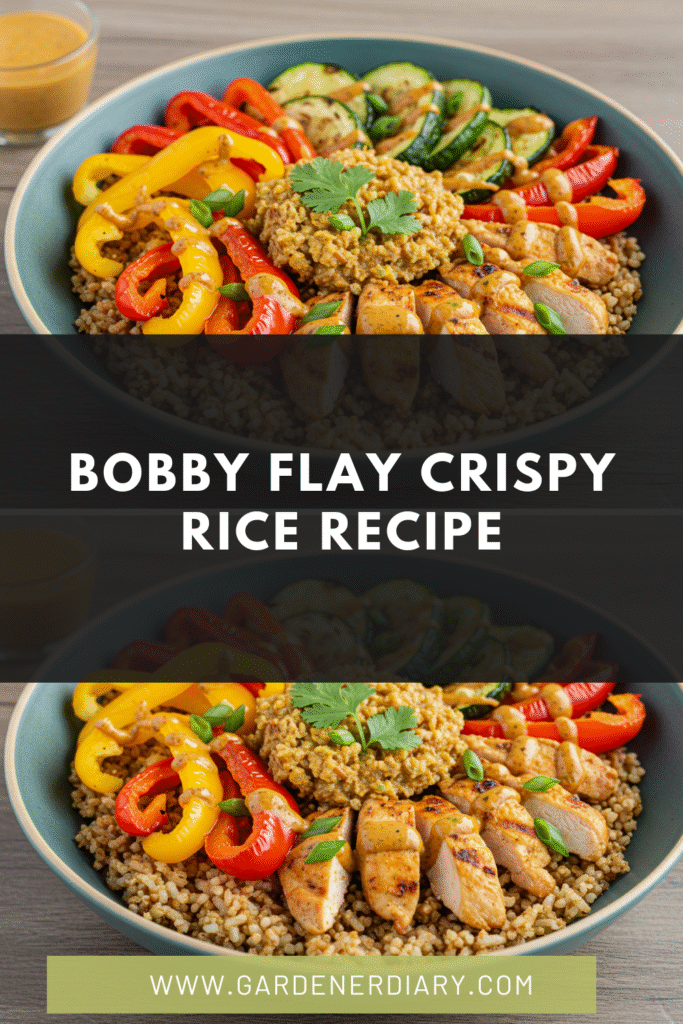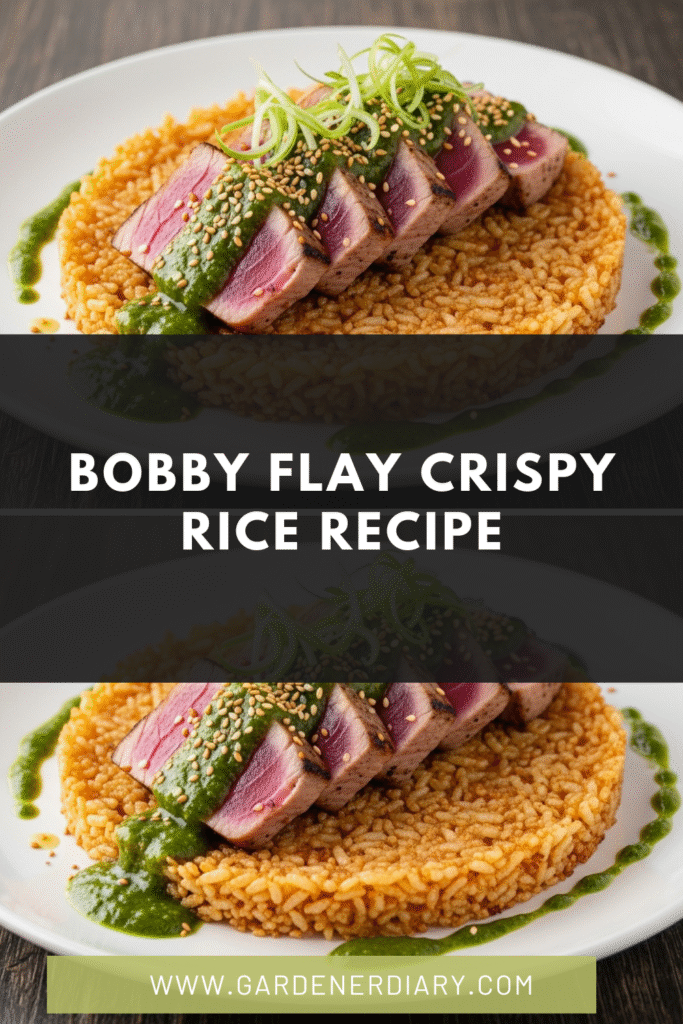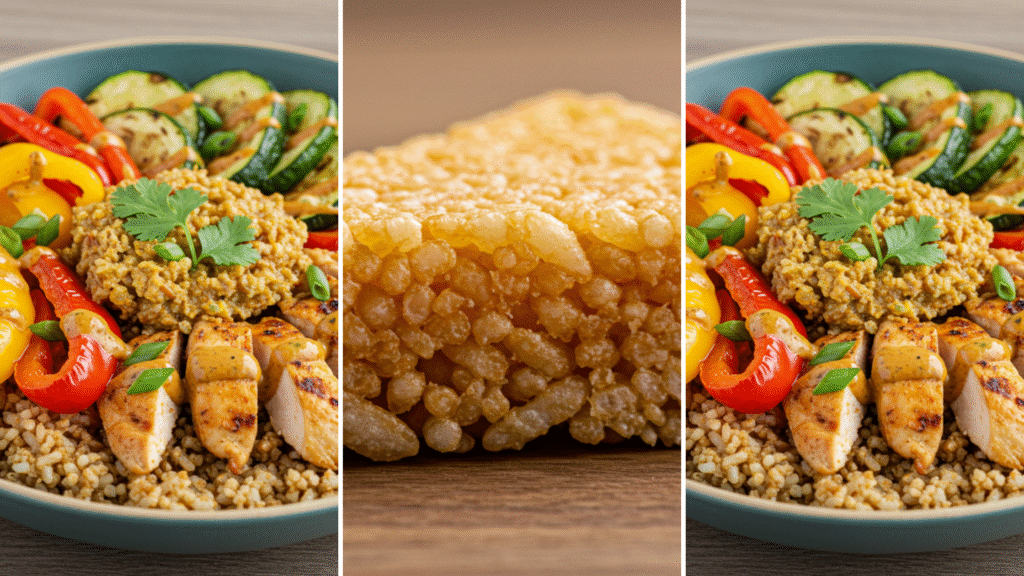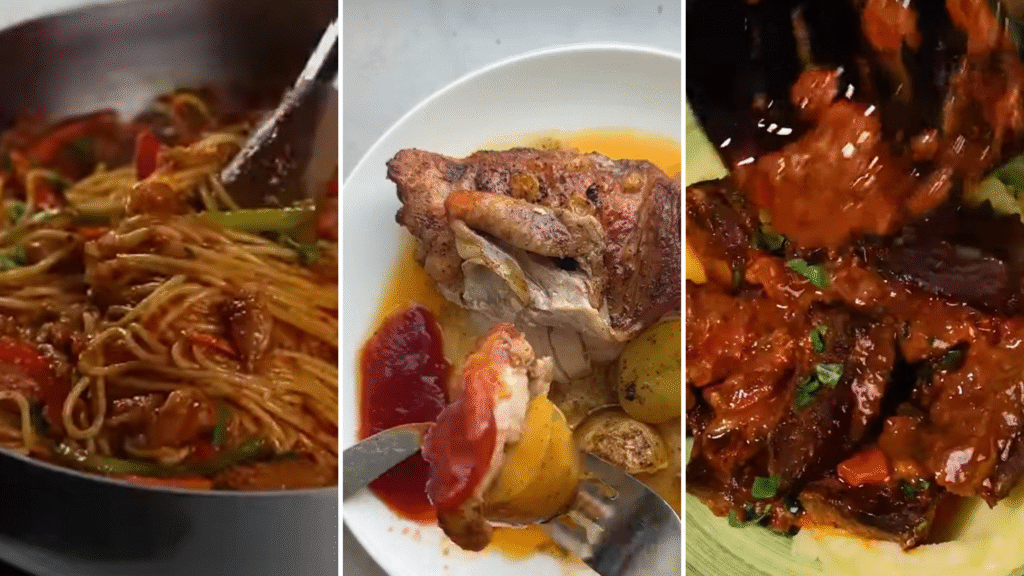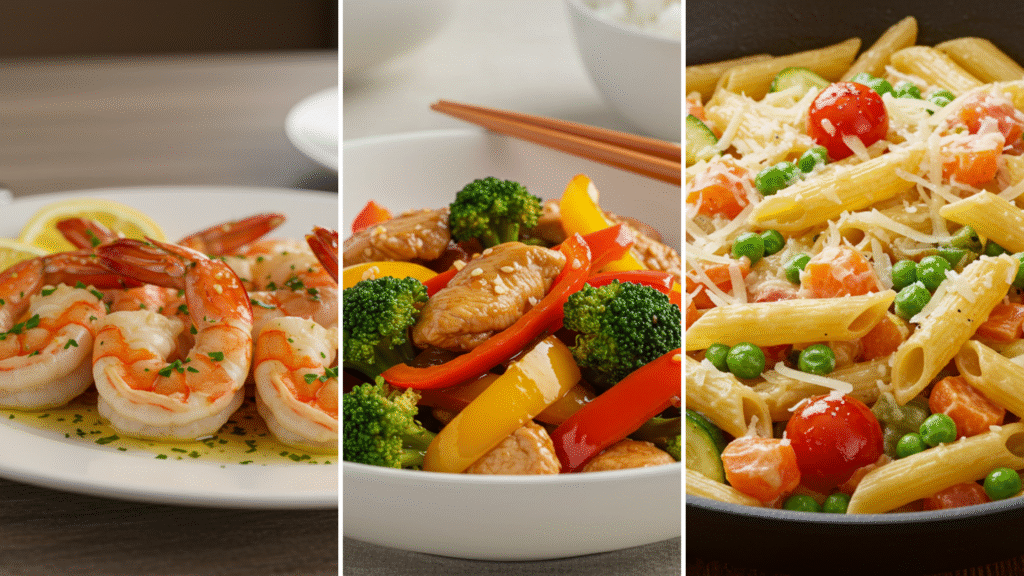Bobby Flay Crispy Rice Recipe: Master the Art of Perfect Golden Crunch
There’s something undeniably satisfying about texture in food. The satisfying crackle of perfectly seared salmon skin, the delightful chew of al dente pasta, or the ethereal crisp of a fresh potato chip. But perhaps one of the most coveted textures in the culinary world is the elusive, golden crunch of crispy rice. It’s a texture that elevates a simple grain into a star component, adding depth and excitement to any dish. And when it comes to mastering flavors and textures, few chefs are as renowned as Bobby Flay. His approach to bold flavors and precise techniques extends beautifully to his take on crispy rice, transforming it from a mere side dish into a culinary experience.
If you’ve ever wondered how to achieve that restaurant-quality crispy rice at home – the kind that’s golden brown, deeply flavorful, and perfectly crunchy without being dry or burnt – you’ve come to the right place. This comprehensive guide will walk you through the secrets behind the Bobby Flay Crispy Rice Recipe, ensuring you can replicate this impressive dish in your own kitchen.
What Makes Crispy Rice So Irresistible?
Crispy rice, often known by its Persian name “tahdig” (meaning “bottom of the pot”), or as a component in various Asian cuisines, is essentially rice that forms a delicious, caramelized crust at the bottom of the cooking vessel. It’s a testament to the magic that happens when simple ingredients meet careful technique and controlled heat. The appeal lies in the contrast: tender, fluffy grains on top, giving way to a rich, nutty, and incredibly crunchy layer below. It adds a textural dimension that elevates any meal.
Why Bobby Flay’s Crispy Rice Stands Out
Bobby Flay, known for his Southwestern flair and grilling prowess, applies his signature touch to this classic concept. His recipes often emphasize maximizing flavor and texture, and his crispy rice is no exception. While the core idea remains the same, Flay’s approach often involves:
- Strategic Fat Usage: Utilizing the right amount and type of fat to achieve even browning and crispiness.
- Precise Heat Control: Understanding how to manage temperature to allow the crust to form slowly and evenly without burning.
- Flavor Infusion: Often incorporating aromatics or spices directly into the cooking process to imbue the rice with deeper flavors from the start.
- The Right Rice: Selecting a rice type that lends itself well to developing a distinct crust while remaining fluffy on top.
Key Components for Perfect Crispy Rice
To achieve Bobby Flay-level crispy rice, you need to pay attention to a few critical elements:
1. The Right Rice
Long-grain or medium-grain white rice is generally preferred for crispy rice. Basmati or Jasmine rice work wonderfully as they cook up fluffy and separate, allowing for a distinct crispy layer to form. Avoid sticky or glutinous rice, as their high starch content will result in a more cohesive, chewy texture rather than individual crispy grains.
2. Proper Rinsing
Rinsing the rice thoroughly until the water runs clear is crucial. This removes excess surface starch, which prevents the rice from becoming overly sticky and promotes individual grain crispiness.
3. The Ideal Cooking Vessel
A heavy-bottomed, non-stick pan or a cast-iron skillet is your best friend here. The heavy bottom ensures even heat distribution, which is essential for uniform crisping. Non-stick properties help with easy release of the crispy crust.
4. Strategic Fat
Butter, ghee, or a neutral oil like canola or vegetable oil work well. Bobby Flay often uses olive oil, sometimes combined with butter for flavor. The fat not only prevents sticking but also helps conduct heat and facilitates the browning process.
5. Controlled Heat and Patience
This is arguably the most important factor. The key is to cook the rice initially, then allow it to steam, and finally, apply gentle, consistent heat to the bottom of the pan to develop the crust without burning the top. Patience is a virtue here; don’t rush the crisping process.
The Science of the Crunch: Maillard Reaction & Starch Gelatinization
What makes crispy rice so magical? It’s a beautiful interplay of two culinary phenomena:
- Starch Gelatinization: When rice cooks, its starch granules absorb water and swell, becoming soft and fluffy.
- Maillard Reaction: As the bottom layer of rice comes into direct contact with the hot, oiled surface of the pan, the sugars and amino acids in the rice undergo a complex chemical reaction (the Maillard reaction). This reaction is responsible for the rich, nutty, savory flavors and the beautiful golden-brown color of the crispy crust. It’s the same reaction that browns toast or sears meat.
Bobby Flay Crispy Rice Recipe: Step-by-Step Guide
This recipe focuses on creating a flavorful, perfectly crunchy rice crust that can be served as a side or a base for various toppings.
Bobby Flay-Inspired Crispy Rice
Ingredients:
- 2 cups (approx. 400g) long-grain white rice (Basmati or Jasmine recommended)
- 3 cups (approx. 720ml) cold water (or low-sodium chicken/vegetable broth for extra flavor)
- 1 teaspoon salt, or to taste
- 2 tablespoons olive oil (or a combination of 1 tbsp olive oil + 1 tbsp unsalted butter)
- Optional aromatics/seasonings: Pinch of saffron threads (steeped in a tablespoon of hot water), a few sprigs of fresh dill or parsley, a pinch of turmeric for color.
Equipment:
- Large, heavy-bottomed non-stick pan or cast-iron skillet with a tight-fitting lid (at least 10-12 inches in diameter)
- Fine-mesh sieve
- Clean kitchen towel
Instructions:
- Rinse the Rice: Place the rice in a fine-mesh sieve and rinse under cold running water until the water runs completely clear. This is crucial for removing excess starch and preventing stickiness. Let it drain for a few minutes.
- Combine & Cook: In your heavy-bottomed pan, combine the rinsed rice, 3 cups of cold water (or broth), and salt. If using saffron, add the steeped saffron water now. Stir gently to combine.
- Bring to a Boil: Place the pan over medium-high heat and bring the mixture to a rolling boil. Stir once or twice to prevent sticking, but avoid over-stirring.
- Reduce Heat & Simmer: Once boiling vigorously and most of the water has evaporated (you’ll see craters forming on the surface of the rice), reduce the heat to the lowest possible setting.
- Add Fat: Drizzle the olive oil (and melted butter, if using) evenly over the surface of the rice. If desired, you can gently make a few small holes in the rice with the back of a spoon to allow steam to escape and fat to penetrate.
- Prepare for Steaming & Crisping: Cover the lid of your pan with a clean kitchen towel (this absorbs condensation and prevents it from dripping back onto the rice, which would hinder crisping). Place the towel-wrapped lid tightly on the pan.
- Steam & Crisp: Cook on the lowest heat setting for 30-45 minutes. The exact time will depend on your stove and pan. Listen for a gentle sizzling sound, which indicates the crust is forming. Do NOT lift the lid during this process!
- Check for Crispiness: After 30 minutes, you can gently tilt the pan and listen for a distinct crackling sound. If you’re unsure, carefully lift the lid for a quick peek. The bottom should be golden brown and crispy. If not, replace the lid and continue cooking for another 5-10 minutes, checking periodically.
- Rest & Serve: Once crispy, remove the pan from the heat and let it rest, still covered, for 5-10 minutes. This allows the steam to loosen the crust from the bottom of the pan.
- Invert: Carefully place a large, flat serving platter or plate over the top of the pan. Using oven mitts, firmly hold the plate and the pan together, then quickly and confidently invert the pan onto the plate. The crispy rice should come out in a beautiful, golden cake.
- Garnish & Enjoy: Garnish with fresh herbs (like chopped dill or parsley) if desired, and serve immediately.
Tips for Achieving Maximum Crispiness Every Time
- Don’t Skimp on Fat: The fat is essential for crisping and preventing sticking. Ensure the bottom of the pan is well-coated.
- Low and Slow is Key: Resist the urge to crank up the heat. A gentle, consistent low heat allows the crust to develop slowly and evenly without burning.
- The Towel Trick: Don’t skip covering the lid with a towel. It absorbs condensation, which is the enemy of crispiness.
- Patience: The crisping phase takes time. Trust the process and avoid lifting the lid too often.
- Listen: The sound of sizzling and crackling is your best indicator that the magic is happening.
- Pan Size Matters: Use a pan wide enough so the rice layer isn’t too thick. A thinner layer allows for more even crisping.
Variations and Serving Suggestions
The beauty of Bobby Flay’s crispy rice recipe is its versatility. Once you’ve mastered the basic technique, you can experiment with flavors and pairings.
Flavor Variations:
- Herby: Add chopped fresh herbs like dill, parsley, or cilantro to the rice before cooking.
- Spicy: A pinch of red pepper flakes or a dash of hot sauce in the cooking water can add a kick.
- Garlic & Onion: Sauté minced garlic or finely diced onion in the fat before adding the rice for an aromatic base.
- Turmeric: A pinch of turmeric powder will give the crispy rice a vibrant golden color and a subtle earthy flavor.
- Citrus Zest: A little lemon or lime zest can add a bright, fresh note.
Serving Suggestions:
- As a Side Dish: It’s a fantastic accompaniment to grilled meats like various chicken recipes, fish, or vegetables. Its texture provides a wonderful contrast to softer main courses. You can even pair it with easy chicken recipes for dinner with few ingredients for a quick yet impressive meal.
- Base for Bowls: Use the crispy rice as the foundation for grain bowls. Top with roasted vegetables, protein (like grilled chicken or tofu), and a flavorful sauce.
- Appetizer: Break the crispy rice into shards and serve with dips like hummus, tzatziki, or a spicy aioli.
- Deconstructed Sushi: Layer with avocado, cucumber, raw fish (if using sushi-grade), and a drizzle of spicy mayo.
Troubleshooting Common Crispy Rice Issues
Even with the best intentions, things can go awry. Here’s how to fix common problems:
- Rice Not Crispy Enough:
- Cause: Not enough fat, heat too low, not enough cooking time, or too much moisture (lid not sealed properly, condensation dripping back).
- Fix: Increase heat slightly (but still low), add a bit more oil around the edges, and extend cooking time. Ensure the towel-wrapped lid is tight.
- Rice Sticking to the Pan:
- Cause: Not enough fat, pan not truly non-stick, or not enough resting time after cooking.
- Fix: Ensure generous fat. If using a cast iron, ensure it’s well-seasoned. Always allow 5-10 minutes of rest time off the heat before inverting.
- Top Rice is Dry/Burnt:
- Cause: Heat too high, or lid not tight enough (allowing too much steam to escape).
- Fix: Reduce heat immediately. Ensure lid is tight and towel is absorbing condensation.
- Crispy Layer is Uneven:
- Cause: Uneven heat distribution (common with thin-bottomed pans), or uneven spreading of rice.
- Fix: Use a heavy-bottomed pan. Ensure rice is spread evenly before covering.
Healthier Twists & Dietary Considerations
While Bobby Flay’s recipe might use a good amount of fat for flavor and crispiness, you can adapt it to suit your dietary needs.
- Reduce Fat: You can slightly reduce the amount of oil/butter, though this might compromise some crispiness. Using a very good quality non-stick pan becomes even more critical.
- Brown Rice: While harder to get perfectly crispy, you can experiment with brown rice. It will take longer to cook and crisp, and the texture will be chewier.
- Gluten-Free: Rice is naturally gluten-free, making this recipe suitable for those with gluten sensitivities.
- Vegan: Use olive oil or another plant-based oil instead of butter.
Incorporating healthy components into your diet is always a good idea. For instance, understanding how to eat chia seeds can provide other nutritious additions to your meals. For those interested in baking, exploring easy bread recipes can also be a rewarding culinary endeavor.
Making Ahead & Storage
Crispy rice is best enjoyed fresh, but you can prepare the rice ahead of time and crisp it just before serving.
- Cooked Rice: Cook the rice as per the initial steps (boiling and simmering until craters form), then cool it completely and store it in an airtight container in the refrigerator for up to 2-3 days.
- Crisping Just Before Serving: When ready to serve, proceed with the “Add Fat” and “Steam & Crisp” steps. This ensures maximum crunch.
- Leftovers: If you have leftover crispy rice, store it in an airtight container in the refrigerator. It will lose its crispiness.
- Reheating: To regain some crispiness, reheat in a dry non-stick pan over medium heat, breaking it into smaller pieces, or spread on a baking sheet and bake at 350°F (175°C) for 10-15 minutes until reheated and slightly crispy.
Conclusion: Your Journey to Crispy Rice Mastery
The Bobby Flay Crispy Rice Recipe is more than just a side dish; it’s a testament to how simple ingredients, when treated with care and precision, can yield extraordinary results. The satisfying crunch, the nutty flavor, and the beautiful golden crust make this dish a showstopper that will impress your family and friends.
By understanding the role of each component, mastering the heat control, and practicing a little patience, you can consistently achieve that coveted perfect crispiness. So, grab your favorite rice, a trusty pan, and embark on your journey to crispy rice mastery. Your taste buds will thank you!
